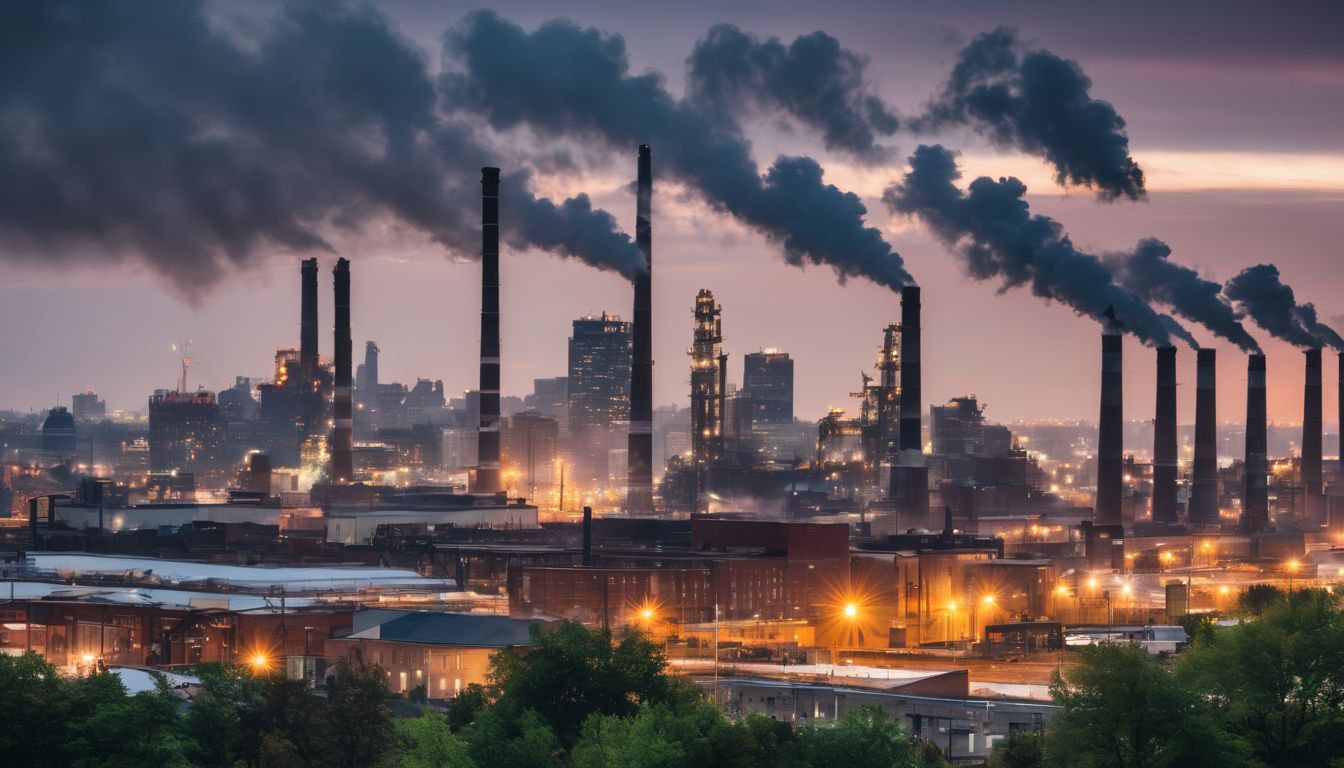As the world grows warmer, our forests are becoming more vital than ever. These natural powerhouses store enormous amounts of carbon, keeping it from heating our planet further. In this post, we’ll explore how forests can cool the globe and why safeguarding them could be a key to a healthier Earth.
Dive in to uncover their silent strength against climate change!
Key Takeaways
- Forests are powerful carbon sinks, absorbing CO2 from the atmosphere through photosynthesis and storing it in trees and soil, which is essential for combating global warming.
- Changes in climate, such as altered precipitation patterns and temperature rises, threaten forest health by increasing risks of droughts, wildfires, pest outbreaks, and biodiversity loss.
- Preserving forests is vital for maintaining local climates; they produce atmospheric moisture leading to rainfall and cool air through shade and transpiration.
- Sustainable forest management can protect against natural disasters like floods while helping us meet emission reduction targets set to combat climate change.
- Action towards forest conservation and reforestation is necessary not just for environmental reasons but also to support livelihoods and achieve United Nations Sustainable Development Goals.
The Impact of Climate Change on Forests
Climate change has major impacts on forests, affecting their ability to store and absorb carbon, changes in precipitation and temperature, and causing disruptions to biodiversity. These changes can have far-reaching consequences for the health and resilience of forest ecosystems.
Carbon storage and absorption
Forests play a critical role in the earth’s carbon cycle by acting as vast reservoirs of carbon. Trees absorb carbon dioxide from the atmosphere through photosynthesis, converting it into biomass and storing it within their trunks, branches, leaves, and root systems.
This process makes forests one of the most significant carbon sinks on the planet, essential for mitigating global climate change.
The continuous growth of forest ecosystems enables an ongoing removal of greenhouse gas emissions from our environment. By maintaining and expanding forested areas through activities like reforestation and sustainable land management, we can enhance this natural form of carbon sequestration.
They not only capture atmospheric CO2 but also contribute to preserving biodiversity conservation by sustaining various plant and animal species which rely on healthy forests for their survival.
Changes in precipitation and temperature
The impact of climate change is also altering precipitation patterns and temperatures in forested areas. These changes can result in more frequent and severe droughts, as well as increased rainfall during certain periods, affecting the delicate balance of forest ecosystems.
Temperature fluctuations may lead to shifts in the distribution of plant and animal species within forests, influencing their overall biodiversity.
Forests play a critical role in regulating local climates by moderating temperature extremes and influencing rainfall patterns through evapotranspiration. However, these functions are at risk due to the changing precipitation and temperature dynamics brought on by climate change.
Effects on biodiversity
Climate change is impacting biodiversity in forests. Changes in temperature and precipitation are altering the habitats of various plant and animal species. This disruption affects the balance of ecosystems, leading to shifts in population dynamics and potential loss of biodiversity.
As forests play a crucial role in supporting diverse plant and animal life, it’s essential to mitigate climate change effects to preserve these invaluable ecosystems.
Moving on from the impact on biodiversity, let’s explore how forests function as vital carbon sinks for mitigating climate change.
The Role of Forests in Mitigating Climate Change
Forests play a crucial role in mitigating climate change by acting as a carbon sink, regulating local and global climate, producing atmospheric moisture and rainfall, and controlling temperature.
Their importance in achieving emission reduction targets cannot be overstated.
Carbon sink function
Forests act as a crucial carbon sink, absorbing and storing large amounts of carbon dioxide from the atmosphere. Through the process of photosynthesis, trees and plants capture CO2, helping to mitigate climate change by reducing the concentration of greenhouse gases.
This not only benefits the local ecosystem but also contributes to global efforts in emission reduction and climate regulation. As forests continue to sequester carbon, they play a pivotal role in maintaining environmental balance and promoting sustainable practices.
The capacity of forests to serve as a carbon sink is essential for offsetting human activities that release CO2 into the atmosphere. By supporting conservation efforts and advocating for responsible forestry management, individuals can contribute significantly to enhancing this vital function of forests in regulating climate and mitigating the impacts of climate change.
Regulation of local and global climate
Forests play a vital role in regulating local and global climates through their carbon sink function, which absorbs large amounts of carbon dioxide from the atmosphere. Additionally, they produce atmospheric moisture and rainfall, contributing to the regulation of local temperatures.
The ecosystem’s regulation helps maintain balanced climate conditions on a global scale by influencing weather patterns and reducing the impacts of extreme temperature fluctuations.
Forests are essential in mitigating climate change as they act as natural air filters, removing harmful CO2 emissions from the atmosphere.
Moreover, stable forests help protect against natural hazards such as floods and landslides while also playing a crucial role in achieving emission reduction targets. By understanding how forests regulate both local and global climates, it becomes evident that their preservation significantly contributes to environmental protection efforts.
Recognising these key ecological functions underscores the urgency for action to safeguard these critical ecosystems for future generations.
Production of atmospheric moisture and rainfall
Forests play a crucial role in the production of atmospheric moisture and rainfall. Through a process called transpiration, trees release water vapor into the atmosphere, which contributes to the formation of clouds and precipitation.
This natural mechanism helps maintain local and regional water cycles, providing essential moisture for agriculture, ecosystems, and communities.
Furthermore, forests help regulate rainfall patterns by influencing air circulation and humidity levels. The presence of trees increases evapotranspiration rates, which enhances cloud formation and supports consistent precipitation.
Control of temperature
Forests play a crucial role in regulating temperature by providing shade and reducing the heat absorbed by the ground. The canopies of trees act as natural umbrellas, preventing direct sunlight from reaching the forest floor.
As a result, forests help to cool down surrounding areas and maintain balanced temperatures. This regulation not only supports diverse ecosystems within forests but also contributes to stabilising local climates.
Moreover, through evapotranspiration, trees release water vapor which cools the air and helps in maintaining humidity levels. This moisture regulates temperature by creating a cooling effect similar to that of an evaporative cooler.
Overall, the presence of forests is essential for controlling temperature and ensuring climate stability at both regional and global scales.
Benefits of Stable Forests in Climate Change Mitigation
Stable forests play a crucial role in mitigating climate change by providing protection against natural hazards and supporting the achievement of emission reduction targets. Their preservation is essential for maintaining a healthy and balanced ecosystem.
Protection against natural hazards
Forests play a crucial role in shielding communities from natural disasters such as floods, landslides, and soil erosion. The dense tree canopies of forests act as natural barriers, reducing the force of wind and preventing soil runoff during heavy rainfall.
Additionally, forests help to stabilise slopes and prevent soil erosion, thus safeguarding against the impacts of extreme weather events.
Furthermore, forests contribute to flood prevention by absorbing excess water during heavy rainfall and releasing it slowly over time. This process helps to regulate river flows and reduces the risk of flooding downstream.
Importance in achieving emission reduction targets
Forests play a crucial role in achieving emission reduction targets by acting as carbon sinks, absorbing and storing significant amounts of carbon dioxide from the atmosphere. This natural process helps to offset human-made emissions, thereby contributing to the mitigation of climate change.
Furthermore, sustainable forest management practices can enhance this capacity, making forests a key ally in efforts to reduce greenhouse gas levels and combat global warming.
Sustainable forest conservation and reforestation initiatives are vital for meeting emission reduction targets. By protecting existing forests and planting new trees, we can enhance the ability of these ecosystems to sequester carbon, ultimately aiding in the fight against climate change.
How Climate Change is Affecting Forests
Climate change is leading to increased risk of wildfires, changes in animal and plant populations, and vulnerability to pests and diseases in forests. These impacts pose significant threats to the health and sustainability of global forest ecosystems.
Increased risk of wildfires
Forests are facing an increased risk of wildfires due to the changing climate. Rising temperatures and drier conditions make forests more prone to ignition, leading to severe and widespread fires.
These wildfires not only pose a threat to forest ecosystems but also release large amounts of carbon dioxide into the atmosphere, contributing to further climate change.
The heightened risk of wildfires highlights the urgent need for sustainable forest management and conservation efforts. Mitigating climate change by reducing carbon emissions is crucial in preventing worsening wildfire risks and safeguarding the health and stability of our forests.
Changes in animal and plant populations
The increased risk of wildfires can lead to significant changes in animal and plant populations. Wildlife habitats are destroyed, leading to displacement or loss of species. The balance between predator and prey relationships is disrupted, affecting the entire ecosystem.
Similarly, plant communities are altered as fire-sensitive species struggle to survive, while fire-adapted species may proliferate.
Plant succession occurs as new vegetation establishes itself after a wildfire, impacting the food sources and shelter available for various animals. Furthermore, changes in precipitation patterns due to climate change also affect the availability of water for plants and animals alike, putting additional stress on these populations.
Vulnerability to pests and diseases
Climate change has led to increased vulnerability of forests to pests and diseases. Warmer temperatures create a more favorable environment for pests, while extreme weather events weaken trees and make them more susceptible to infestations.
Pests like bark beetles are expanding their range due to milder winters, causing widespread tree mortality. Disease outbreaks, such as sudden oak death and chestnut blight, are also on the rise as changing climate conditions affect the health of forest ecosystems.
Furthermore, the spread of invasive species that thrive in warmer climates poses a threat to native flora and fauna. These factors collectively contribute to the decline of forest health and resilience against environmental stressors.
The Future of Forests and Climate Change
Forests play a crucial role in achieving sustainability and meeting United Nations Sustainable Development Goals. It is essential to take action and preserve forests for the benefit of future generations.
Importance of sustainability
Forests play a crucial role in regulating the climate, making sustainability vital for their preservation. Sustainable management practices ensure that forests continue to serve as carbon sinks, absorbing and storing carbon dioxide from the atmosphere.
By maintaining healthy ecosystems and biodiversity, sustainable forestry helps regulate local and global climates, contributing to carbon mitigation efforts.
Furthermore, sustainability in forest management is essential for combating deforestation and promoting carbon offsetting. It also supports the protection of natural habitats and wildlife populations, which are increasingly vulnerable due to the impacts of climate change.
Role in achieving United Nations Sustainable Development Goals
Forests play a crucial role in achieving United Nations Sustainable Development Goals by contributing to several key areas such as climate action, life on land, and partnerships for the goals.
They act as essential carbon sinks, aiding in the reduction of greenhouse gas emissions and mitigating climate change. Forest conservation also supports biodiversity, helping to sustain ecosystems and protect endangered species.
Furthermore, forests provide livelihoods for millions of people worldwide, contributing to the goal of promoting sustainable economic growth and decent work for all.
Moreover, forests are pivotal in fostering partnerships for sustainable development by involving local communities, governments, non-governmental organisations (NGOs), and businesses in forest management and protection efforts.
The need for action and preservation of forests
Forests play a crucial role in regulating Earth’s climate and maintaining global ecological balance. As environmentally conscious individuals, it’s imperative to take action to preserve forests by supporting conservation efforts and sustainable land use practices.
By protecting existing forest cover and promoting reforestation, we can help mitigate the impacts of climate change, safeguard biodiversity, and ensure the availability of essential ecosystem services for future generations.
Further investment in research, policy frameworks, and international cooperation is also necessary to address the increasing threats facing forests worldwide. Embracing a proactive approach towards forest preservation will contribute to a more resilient planet and healthier ecosystems for all living beings.
This commitment goes hand in hand with our collective responsibility to protect natural resources – including forests – against environmental degradation and unsustainable exploitation.
Conclusion
In conclusion, forests play a vital role in regulating the Earth’s climate. They act as natural carbon sinks, absorbing and storing carbon dioxide from the atmosphere. Forests also help regulate local and global climate patterns by producing atmospheric moisture, controlling temperature, and supporting biodiversity.
In order to mitigate the effects of climate change, it is imperative that we take action to preserve and sustainably manage our forests for the benefit of current and future generations.
FAQs
1. How do forests help regulate the climate?
Forests play a crucial role in regulating the climate by absorbing carbon dioxide, which helps with carbon removal from the atmosphere.
2. Can trees really absorb that much carbon dioxide?
Yes, trees are very good at taking in carbon dioxide and using it to grow, which significantly aids ecosystem regulation and combats climate change.
3. What happens if we lose our forests?
If we lose forests, we also lose their ability to absorb large amounts of carbon dioxide, impacting their vital role in climate regulation.
4. Are all types of forests important for climate control?
All types of forests contribute to regulating our climate by removing carbon from the atmosphere through the natural process of photosynthesis.





